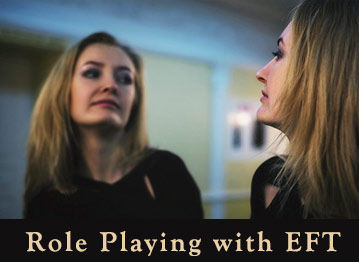 Role playing is an accepted strategy that can be used to learn how to handle a feared situation in a more constructive way. A therapist (or a friend) will ad lib the role of the antagonist (although later he/she sometimes reverses roles and enacts the role of the other person), and in the case of a client client session, the individual usually plays their self.
Role playing is an accepted strategy that can be used to learn how to handle a feared situation in a more constructive way. A therapist (or a friend) will ad lib the role of the antagonist (although later he/she sometimes reverses roles and enacts the role of the other person), and in the case of a client client session, the individual usually plays their self.
Traditionally, it’s been a form of emotional re-education, but when used along with EFT Tapping it can often change behavior in a dramatic manner and affords a superb opportunity to assess the effectiveness of the tapping right there and then.
Here’s an example of how this worked for Dr. Pat:
“Janet” who worked as an executive secretary, came into a session with me extremely agitated because her boss was demanding that she spend a good deal of overtime preparing a presentation for him to use at a national conference. She was capable of doing this job extremely well, but he had also just assigned to her another important project which was already taking more than her full time. It was quite clear that she couldn’t do both and that she was going to have to refuse the new assignment. But she dreaded doing this because saying “no,” even to unreasonable requests, had always been painful for her. She did not know how to present dissent in an acceptable and gracious manner.
There were many historical incidents in Janet’s background which had set the stage for her fear of speaking up for her own rights, including sexual abuse in childhood and a prolonged childhood illness. Furthermore, she had repeatedly been forced to defer silently to alarming demands when growing up. However, there was an immediate need to clarify the issue with her boss, and therefore we turned to the situation itself, rather than its historical antecedents in this case.
Janet would have to tell him that she was unable to do the new assignment, so I asked her to role play the scene, with me enacting the role of her boss. She agreed and I assumed the role of her boss who was busy looking over his papers when she entered his office.
“What is it, Janet,” I asked abruptly (as boss). She said, “I want to tell you something. I’m awfully sorry but I just don’t see any way I can do that new assignment. I’m going to have to tell you that I can’t do it.” As she said this she had an absolutely crushed look on her face and her voice dropped nearly to a whisper as she ended her declaration. There was an unreal rehearsed quality to her words which told me (as boss) that she had no conviction in back of her statement.
I used the role playing to experience how the boss would react to her words. I immediately knew he would be thinking to himself something like, “She’ll do it because she’s scared. She doesn’t mean a word that she’s saying.”
I shared this reaction with Janet, and she sheepishly nodded and said my appraisal was correct.. Rather than let her talk about it further, I suggested that we do EFT right away and she came up with the following setup phrase:
“Even though I’m afraid to say no to my boss, I choose to feel OK about it.” The first part of her setup phrase (statement of her fear) was appropriate; but the last part seemed weak and wishy-washy to me. I just didn’t think it could do the job. Just feeling “ok”? That’s not a very upbeat emotion. I felt she needed something stronger than that to counteract her fear.
On questioning, she was able to tell me that she was afraid of being rude, ungracious, and too aggressive if she refused the boss’s request. This was clearly a “tail-ender” (Gary Craig’s description of “tail-enders,” is unexpressed conflicts and reservations that can undermine an affirmation). The tail-ender prevented her from wholeheartedly choosing to confront her boss effectively. We therefore quickly built this tail-ender into a Choice Set-Up phrase (see Choices for a description of the use of Choices in the Set-Up phrase).
I asked her how she would really LIKE to act in this situation, and she said she would like to be “firm” — the concept of being “firm” seemed very desirable to her. I suggested she also add the word “gracious” to the set-up phrase to take care of her fear of being over-aggressive, unpleasant and unacceptable in the way she would confront him (her tail-ender). The wording we settled on went was “I choose to be gracious but firm with him.”
After several rounds of EFT Janet’s SUDS level (stress rating on a 0 to 10 point scale) had come down from a 10 to a 4 and it was time for us to run through the role-play again so that I could see if there was any change in her behavior. We played the scene over again and I was excited to hear the difference in her voice. She was much crisper, more definite, and her words were stronger and clearer.
She said, “I want to talk to you about something. I realize that it’s not possible for me to do both projects, the one I’m already working on and this new one. I just won’t be able to do them both.” While she was not yet as firm as she needed to be for me (playing the boss) to respect her fully, I already had a different attitude as I listened to her. I knew that this was not going to be an easy situation and that she meant business, that she really was in a difficult spot. I (as boss) began to think that maybe she really couldn’t handle both jobs at once, something which apparently had not occurred to me before.
We then continued with EFT. She did the Choice Trio using the same set-up phrase, and when she was finished she said she felt a lot better about telling this to her boss. I could see that she did. She was sitting up much straighter in her chair, her eyes were bright and her chin was lifted “firmly.”
I said, “OK, we’re going back to the beginning, you’re coming into the office, I am busy looking over my papers, and I say, “What is it Janet?”
“I have something I want to talk over with you.” she said in a clear “listen-to-me” voice. “I’ve been thinking a lot about the assignment you want me to do, and of course it’s one I am interested in doing and would certainly want to do for you. But I’m afraid that this time I’m not going to be able to do it and still fulfill the other obligations and deadlines we’ve agreed on. The two cannot be done by one person at the same time. However, I have some suggestions about who I think could step in and help you with this, if you’d like to hear them.”
I didn’t need to hear another word. She was crisp, definite and poised — and indeed she was gracious. As boss, this gave me great respect for her, a respect I had not previously felt in our enactments of this scene. I knew that she knew what she was talking about, that she was correct, and that she was going to try to be helpful to me.
I immediately shared my new, very positive reaction to her behavior with Janet and she commented to me that she felt she would be able to talk to her boss now with no problem. I knew she meant it. So, when she returned the following week to tell me the talk with her boss had gone extremely well and she no longer needed to work on this issue, I was not in the least surprised.
Role playing had enabled me to add several very nice features to our EFT work. One was the feedback I was able to give her along the way which helped her adopt a new attitude about herself. Another was that the EFT process had been vivified, made real, and brought directly into the therapeutic session, through the role playing. I urge any of you who are comfortable with role playing – I was extremely so – to try out this combination and see how it can enrich your EFT work.
EFT Master, Dr. Patricia Carrington
Related Products
The Power of Personal Choice in EFT
You’ll find a basic introduction to the EFT Choices Method in this eBook, which can put you well on your way to mastering this popular self-help technique.







